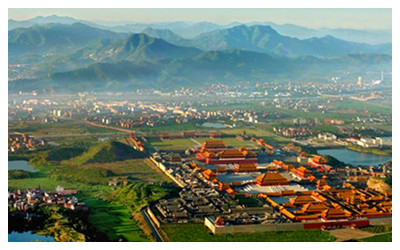Skype: neodalle-travel
Tel: +86 135 7447 2266
E-mail: sales@visitaroundchina.com
 The large studio houses both landscape scenes and architecture: from the old to the new, from the grand to the humble, which are quite a variety!
The large studio houses both landscape scenes and architecture: from the old to the new, from the grand to the humble, which are quite a variety!Fantasy Valley: Fantasy Valley focuses on natural catastrophe, such us the eruption of a volcano, heavy storms, and floods. Also, it is a theme park for nighttime films, which is equipped with various special effects gadgets. Fantasy Tai Chi emulates volcanic eruptions almost guarantied to awe. On a total area of 79.7 acres (32.3 hectares), the valley consists of the Dream Culture Village, the Water World, Children's Dream Industry and the South of the Lower Reaches of the Yangtze River.
Ming and Qing Palace Area: Built in 1998, the Ming and Qing Palace Area is a same scaled model of the Forbidden City. Magnificent palaces, splendid imperial gardens, sublime mansions of royal family, grand government offices, and folk houses are all found here. It is the largest film production studio on site, with a total area of 247 acres (100 hectares).
Palace of Emperor Qin: The studio's Palace of Emperor Qin was built in 1997. It is modeled after the fabled royal Xianyang Palace, Qin Dynasty (221-207 BC). The main halls, annex, towers, and gates are some twenty-seven structures. The city wall has a girth of 1.6 miles (2.5 kilometers), and a maximum height of 59 feet (18 meters). Over 500 films have been made here, making the Palace of Emperor Qin a cradle of historical films.
Riverside Scene: The Riverside Scene renders a street scene from a historical painting by Zhang Zeduan live. Tourists may get into the hustle and bustle back in time – by a thousand years. The theme is divided into the outer city and the inner city, covering a total area of more than 99 acres (40 hectares). There are over 120 houses, 6 bridges, 9 wharves, 6 boats and 14 archways. Breathtaking!
Guangzhou Street and Hong Kong Street: The Guangzhou Street looks exactly like Guangzhou from a photo taken in the 1840s. It caters to honeymoon seekers. Also, it is one of the most sought after backdrop for wedding photography. There are more than thirty European style buildings in Hong Kong Street, indicating the prosperity of the Victorian City in the 19th century.
Ming and Qing Folk Houses: The Ming and Qing Domestic Houses comprise of the Qinhuai River Scenic Spot and the Peach Flower Scenic Spot. The former centers on the Qinhuai River and Confucius Temple and presents the prosperous scenes of the ancient city, Nanjing. The latter is the preserve of ancient Chinese folk houses. There are more than two hundred folk houses of the Ming Dynasty (1368-1644), Qing Dynasty (1644-1911), and the Republic of China, which were relocated here from Zhejiang Province, Anhui Province, and Jiangxi Province. These houses cover a total area of more than 148 acres (60 hectares). You will appreciate Chinese folk architecture when roaming among these houses.
Chinese Cultural Garden: Walking to the south end of the Hengdian World Studios, you will find the Chinese Cultural Garden. The Three Religions Tower is depository for cultural artifacts reflecting the thoughts of Confucianism, Buddhism, and Taoism.
Rocky Grotto: The Rocky Grotto is renowned as the First Grotto in the Lower Reaches of the Yangtze River. The grotto has precipitous cliffs, the strange grotto, the red leaves, and the buildings above the ground. You will revel in the beauty of nature. There are also a great number of Taoist temples built along the cliffs. Splendid!
Dazhi Buddhist Temple: The Dazhi Buddhist Temple was constructed around (502- 557), or 1500 years ago. You can see the Mahavira Hall, the Hall of Heavenly King, the Hall of Arhats, the Bell Tower, and the Drum Tower. The temple exudes harmony and peace.
National Defense Garden: Visitors can trace the history of China's aeronautics and space development in the National Defense Garden. There are many exhibition halls, such as: the Military Parade Hall, the armament of air, sea, and land forces, and the Space Exploration Hall.
Travel Tips
Add: Dongyang Town, Jinhua City of Zhejiang Province
Opening Hours: 08:00-19:00
Transport: Take a coach to Hengdian from Jiangdong Passenger Station for about CNY 15. The coach operates from 6:00 to 15:50. The frequency is 30 minutes, and the trip duration is about one hour.
 Ask Questions ?
Ask Questions ?